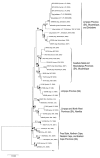Epidemiology and molecular virus characterization of reemerging rabies, South Africa
- PMID: 18258039
- PMCID: PMC2874428
- DOI: 10.3201/eid1312.070836
Epidemiology and molecular virus characterization of reemerging rabies, South Africa
Abstract
The incidence of dog rabies in Limpopo Province, South Africa, increased from 5 cases in 2004 to 100 in 2006. Human rabies had last been confirmed in 1981, but investigations instituted after an index case was recognized in February 2006 identified 21 confirmed, 4 probable, and 5 possible human cases between August 5, 2005, and December 31, 2006. Twelve of these case-patients were identified retrospectively because the diagnosis of rabies was not considered: 6 of these patients consulted a traditional healer, 6 had atypical manifestations with prominent abdominal symptoms, and 6 of 7 patients tested had elevated liver enzyme activity. Molecular genetic analysis indicated that outbreak virus strains were most closely related to recent canine strains from southern Zimbabwe. Delayed recognition of the human cases may have resulted from decreased clinical suspicion after many years of effective control of the disease and the occurrence of atypical clinical presentations.
Figures




References
Publication types
MeSH terms
LinkOut - more resources
Full Text Sources
Medical
